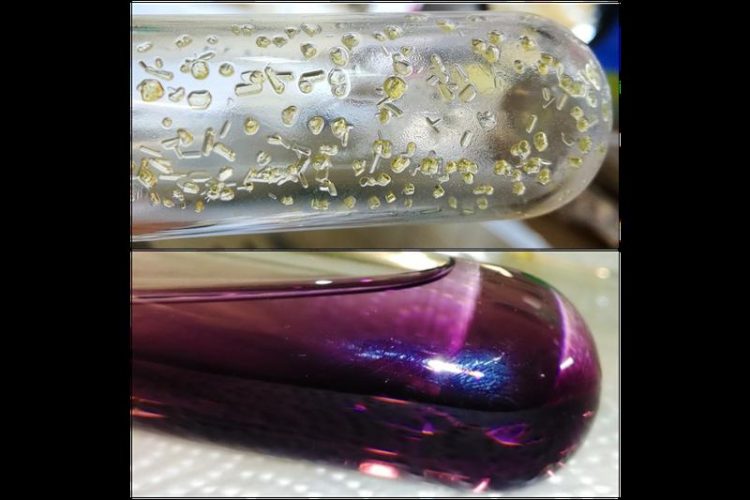Finally available in a bottle

Metal carbonyl complex filled in a bottle. Photo: AG Krossing/J. Bohnenberger
Since the discovery of the first homoleptic metal carbonyl complex Ni(CO)4 more than 130 years ago, scientists try to obtain further such compounds formed from a carbon monoxide molecule and a metal that are important for basic research as well as applications.
The last new compound of this type to be bottled, the Co(CO)5 cation, was reported in 2003. However, extensive research in the gas phase has shown that far more metal carbonyl complexes than those known to date should exist, including the chromium hexacarbonyl cation.
A team led by the chemists Prof. Dr. Ingo Krossing from the University of Freiburg and Prof. Dr. Frank Breher from the Karlsruhe Institute of Technology were able to prepare this compound in common solvents and fill it into a bottle as a stable compound in crystalline form. They present their results in the journal Nature Communications.
“For over fifty years, researchers have been trying to prepare this highly studied and dynamic floppy molecule as a substance that can be bottled,” explains Krossing.
The research groups from Freiburg and Karlsruhe produced a combination of a strong oxidizing agent [NO]+ and a weakly coordinating anion, which enables the oxidation of Cr(CO)6, chromium hexacarbonyl, and isolated its room temperature stable radical salt.
Normally [NO]+ leads to a coordination of the released nitrogen monoxide, but the researchers were able to suppress this with suitable reaction conditions. In the end, they succeeded in filling the stable compound, which, as found in the experiments, has several isomeric structures close in energy, into bottles as a solution and as crystals.
“Since we have used standard laboratory equipment and Schlenk techniques as well as common solvents for our method,” said the professor from Freiburg, “it can now be used in all chemical laboratories and can therefore be used for a wider range of applications.
Original publication:
Bohnenberger, J., Feuerstein, W., Himmel, D., Daub, M., Breher, F., Krossing, I. (2019): Stable salts of the hexacarbonyl chromium(I) cation and its pentacarbonyl-nitrosyl chromium(I) analogue. In: Nature Communications. DOI: 10.1038/s41467-019-08517-2.
Contact:
Prof. Dr. Ingo Krossing
Institute for Inorganic and Analytical Chemistry
University of Freiburg
Tel.: 0761/203-6122
ingo.krossing@ac.uni-freiburg.de
https://www.pr.uni-freiburg.de/pm-en/press-releases-2018/finally-available-in-a-…
Media Contact
All latest news from the category: Life Sciences and Chemistry
Articles and reports from the Life Sciences and chemistry area deal with applied and basic research into modern biology, chemistry and human medicine.
Valuable information can be found on a range of life sciences fields including bacteriology, biochemistry, bionics, bioinformatics, biophysics, biotechnology, genetics, geobotany, human biology, marine biology, microbiology, molecular biology, cellular biology, zoology, bioinorganic chemistry, microchemistry and environmental chemistry.
Newest articles

Security vulnerability in browser interface
… allows computer access via graphics card. Researchers at Graz University of Technology were successful with three different side-channel attacks on graphics cards via the WebGPU browser interface. The attacks…

A closer look at mechanochemistry
Ferdi Schüth and his team at the Max Planck Institut für Kohlenforschung in Mülheim/Germany have been studying the phenomena of mechanochemistry for several years. But what actually happens at the…

Severe Vulnerabilities Discovered in Software to Protect Internet Routing
A research team from the National Research Center for Applied Cybersecurity ATHENE led by Prof. Dr. Haya Schulmann has uncovered 18 vulnerabilities in crucial software components of Resource Public Key…





















